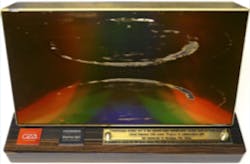Horiba France's diffraction grating exhibited at the Nobel Museum
A diffraction grating developed by Horiba France (Palaiseau, France) has been added to the collection of the Nobel Museum in Stockholm, Sweden. 2018 Nobel Prize winner Gérard Mourou, who invented the chirped pulse amplification (CPA) technique used to create ultrafast laser pulses down to the few-femtosecond level, was asked to offer an item for exhibition at the Nobel Museum to commemorate his receipt of the award, he chose the diffraction grating used in his laboratory, which was a Horiba grating designed to withstand high pulse energies.
Reported on by Mourou in 1985, CPA is a technique for stretching out an ultrafast laser pulse using a diffraction grating; after the pulse is amplified by an optical amplifier, the pulse is compressed in duration, again using a diffraction grating. At the time, diffraction gratings were not able to withstand strong radiant fluxes and amplifiers were liable to break when irradiated with strong luminous fluxes.
To overcome these challenges, Horiba France (then Jobin Yvon) worked to enhance the durability of diffraction gratings against luminous fluxes. As a result, it became possible in the 1990s to increase the laser strength by a factor of 1000. Applications made possible by the improved grating include LASIK eye and corneal refractive surgery, femtosecond ophthalmology, proton-beam therapy aided by high-intensity ultrafast lasers, and radioactive waste disposal (high-intensity laser radiation can significantly shorten the life of long-life atoms and achieve stable nuclear transformation, thus enabling long-term storage of radioactive waste).
Source: Horiba
About the Author
John Wallace
Senior Technical Editor (1998-2022)
John Wallace was with Laser Focus World for nearly 25 years, retiring in late June 2022. He obtained a bachelor's degree in mechanical engineering and physics at Rutgers University and a master's in optical engineering at the University of Rochester. Before becoming an editor, John worked as an engineer at RCA, Exxon, Eastman Kodak, and GCA Corporation.

